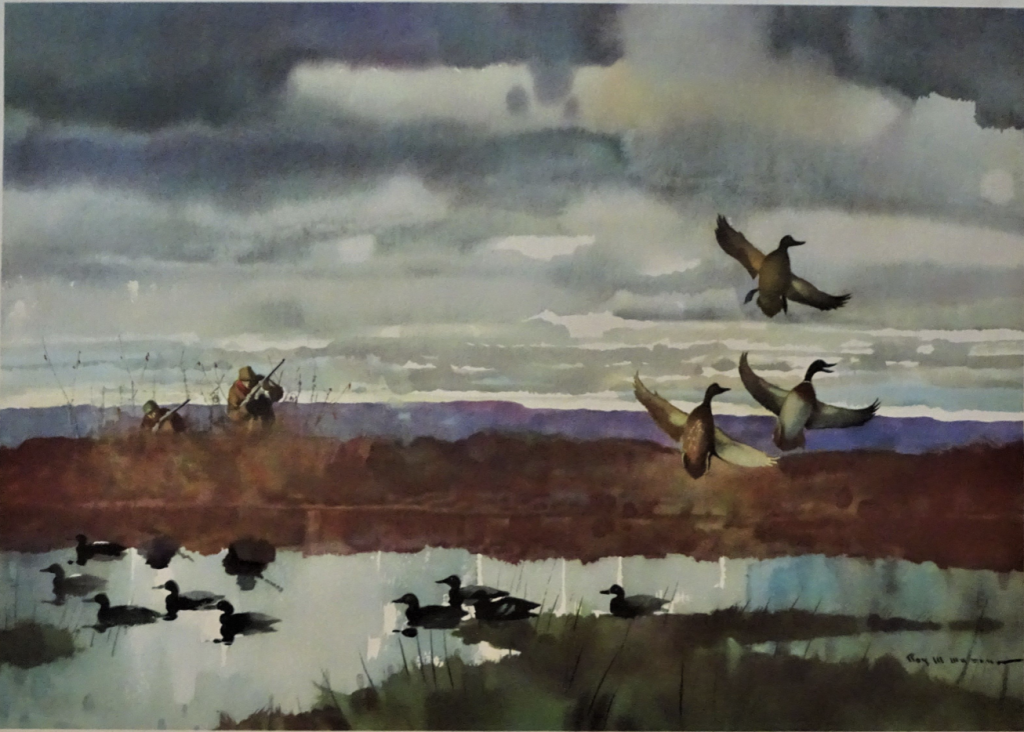
by Brooke Chilvers
It feels wonderful to be washed over by Enlightenment, when the pieces of a kaleidoscopic cultural puzzle suddenly fit together in your mind. Like when you viscerally sense the connection between African masks and Picasso, or Kandinsky’s path from painting Bavarian landscapes to transcribing the universe.
Understanding what came before as well as after is at the heart of such revelations. Like when you discern the influence of sporting art’s outdoor watercolorist Roy Martell Mason (1886–1972) in the still mountains and moving waters of Thomas Aquinas Daly, or in Chet Reneson’s foamy surf and far-flung skies.

I wrote about Mason’s life, his education and inspiration in The Ever-Disappearing Roy M. Mason. Art was in his blood through his father, a gunstock engraver who later created a substantial family business that produced embossed seals and labels. Roy and his also-artist siblings, Nina and Max, worked there while also working away at their art. For years, Roy was the company’s art director and general manager; presumably, the steady income allowed him a certain freedom of expression.
Although there were no Grand Tours or art academies in his education, Roy knew how to learn from others. He likely mastered visualizing the patterns in nature at different depths of field from post-impressionist landscape painter Chauncey Ryder (1868–1949). Norman Kent (1903-1972), one of Mason’s biggest fans, showed the way for balancing blocks of relative dark and light; and Hobart Nichols (1869–1962) expertly demonstrated the use of highlights to direct the viewer’s eye.

Mason, in turn, passed on his own hard-earned lessons on mastering tricky watercolors to a new generation of sporting artists. The painter of gamebirds on the wing, David Hagerbaumer (1921–2014), considered Mason his direct mentor. He credited Mason with setting the example in using more expensive English-made Winsor & Newton pigments, and may even have suggested Hagerbaumer’s palette—so close to his own—of burnt sienna, earthy umbers, leafy Hooker’s green, and a cobalt blue that creates interesting textures. Mason led him to use the best sable brushes, as well as sharp-tipped, flexible-bodied sumi brushes whose water-holding capacity is vital to the Japanese-like calligraphic skill and spontaneity required for the fine strokes needed to capture the tips of flying feathers or reeds bowing with the wind.

Contemporary sporting artist C.D. Clarke says that Mason had real impact on his career “before I even knew who he was!” As a kid already interested in hunting, C.D. was drawn to the Mason print hanging in the basement rec room of a pal. When the family moved, Clarke, who by then knew all about Mason, found it in the trash, the frame and glass broken. “I reframed it and it hung in my Maryland studio until it was lost in the fire that took my studio some 20 years ago.”
Luckily, he tracked down another copy of the 1920s print, Three Mallards, Duck Hunting, and it hangs today in his New Jersey studio. “I still love it as much, or even more, than when I first saw it.” Clarke says he especially appreciates how accurately Mason captured “an upstate New York autumn atmosphere. It is the perfect Great Lakes, duck-hunters sky.”
